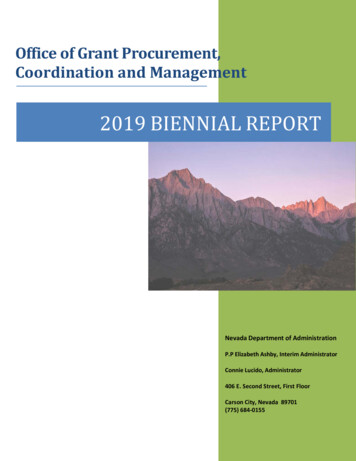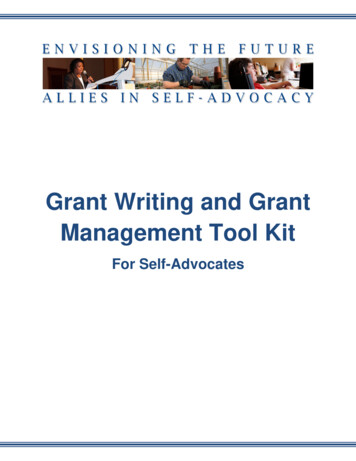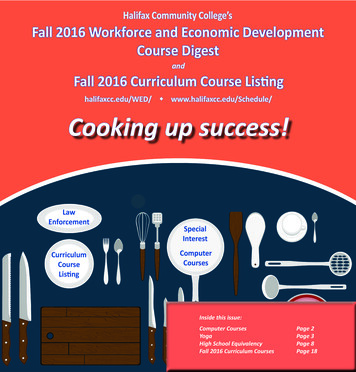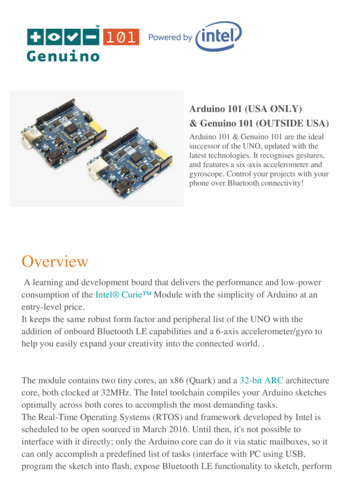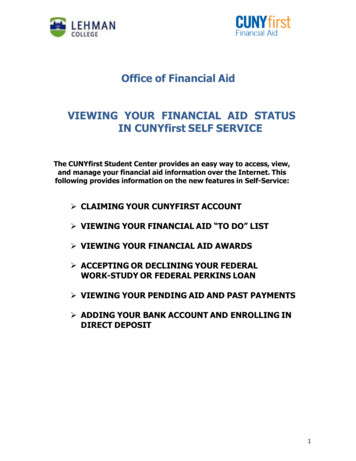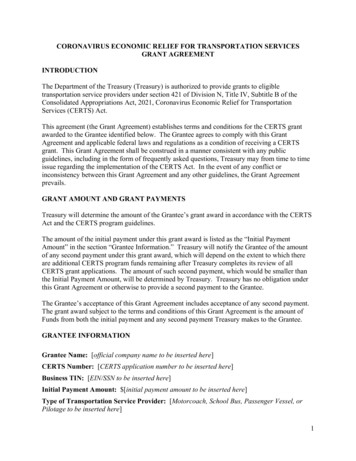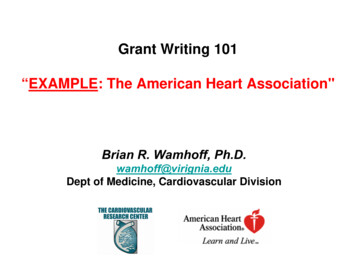
Transcription
Grant Writing 101“EXAMPLE: The American Heart Association"Brian R. Wamhoff, Ph.D.wamhoff@virignia.eduDept of Medicine, Cardiovascular Division
Other mechanisms: NIH – K99 AwardJDRFADAAPSNRSAACS
Science Focusof the AHA“Research broadly related to cardiovascular functionand disease, stroke or related to clinical, basicscience, bioengineering or biotechnology, and publichealth problems.”
"Optimizing your funding success with theAmerican Heart Association"1. My personal experiences with the AHA2. The AHA Mid-Atlantic and National Affiliates3. How the Review Process Worksa. Reviewing the Pre- and Post-DoctoralFellowship and Grantsmanship Tipsb. Reviewing the Scientist Development Grant& the Beginning Grant-in-Aid4. Concluding remarks
My personal experiences with the AHAPre-doctoral Fellowship1999 – 2001 AHA Heartland Affiliate, “Smooth muscle calcium regulation:Cardioprotective effects of exercise in diabetic swine with coronary artery disease.”University of Missouri, PI: Michael Sturek, Ph.D.Post-doctoral Fellowship (declined for APS fellowship)2002 – 2004 AHA Mid-Atlantic Affiliate, “Molecular mechanisms of decreased smoothmuscle differentiation marker expression associated with the pathophysiology ofatherosclerosis.” University of Virginia, PI: Gary K Owens, Ph.D.Scientist Development Grant (accepted), Beginning Grant-in-Aid (rejected)2005 – 2009 National Affiliate. “Calcium-dependent regulation of smooth musclephenotype.” University of Virginia, PI: Brian R. Wamhoff, PH.D.Used SDG to generate data for current NIH RO1 – 07/01/06 – 06/31/11Study Section2005 – AHA National Affiliate BASIC 1 Study SectionBoard of Directors2005 – AHA Local Affiliate, spokesperson for AHA impact on UVA funded researchand training young cardiovascular scientists
The AHA Mid-Atlantic and National html?identifier 10813Mid-Atlantic AffiliateNational Affiliate also collectively reviewsNational, Greater Midwest, Heartland andPacific Mountain AffiliatesDeadline:Jan, 2007Deadline:July, 2006Jan, 2007Offering Programs:Offering Programs:Pre-doctoral (29/115 25% down from 34%)Post-doctoral (21/99 21% up from 15%)Scientist Development Grant* (85/356Beginning Grant-in-Aid (22/74 30% up24%, 65K, 3-4y)from 14%)Grant-in-AidFellow-to-Faculty
NIH paylines are dropping at an astounding rate!Current pay lines are 12% for NHLBI, down fromapproximately 20-24% in 2004-05SOLUTION: Start writing good grants early in yourcareer because this is what you will be doing for therest of your career, in good times and bad!Post-docs that have funding keep their jobs.
Current AHA Funded Proposals at CVRCMid-Atlantic AffiliateNational AffiliatePre-doctoral fellows ( 20K2 1y):Scientist Development Grant( 66K, 4y):Jeremy MauldinJames ThomasMatt AlexanderBrian WamhoffTadashi YoshidaPost-doctoral fellows ( 35K2 1y):Elena GalinkaTracy DeemAnthony OreBeginning Grant-in-aid ( 66K2y):Elaine Felecia EtterBrant Isakson
How the Review Process Works“Prior to Study Section”Proposals are assigned to a studysection based on the specific“codes” you select for describingyour grant.
Science Focus“Research broadly related to cardiovascular functionand disease, stroke or related to clinical, basicscience, bioengineering or biotechnology, and publichealth problems.”
The proposal doesnot need to berelated to CVD!Mid-Atlantic AffiliateMid-Atlantic 1AIntegrative Cardiac Biology/RegulationRadiology & imagingSurgeryMid-Atlantic BElectrophysiology & Arrhythmias/RegulationVascular Biology & Blood Pressure/RegulationCardiovascular Regulation (autonomic regulation)Mid-Atlantic 2Lipoproteins & Lipid MetabolismThrombosisVascular Wall BiologyMid-Atlantic 3CardiorenalLung, Respiration & ResuscitationImmunology & MicrobiologyMid-Atlantic 4Cell Transport & MetabolismCellular CV Physiology & PharmacologyMid-Atlantic 5Molecular SignalingMid-Atlantic 6Basic Cell & Molecular BiologyCV Development
The proposal doesnot need to berelated to CVD!National AffiliateBasic Cell & Molecular Biology 1 (25 members)Basic Cell & Molecular Biology 2Behavioral Science, Epidemiology & PreventionBioengineering & BiotechnologyBrainCardiorenalCardiovascular DevelopmentCardiovascular Medical Research and Education FundCell Transport Function & Metabolism/Electrophysiology & ArrhythmiasImmunology & MicrobiologyIntegrative Cardiac Biology/RegulationLipoproteins, Lipid Metabolism & NutritionLung, Resuscitation & RespirationMolecular Signaling 1Molecular Signaling 2Radiology, Imaging & SurgeryThrombosisVascular Biology & Blood Pressure/RegulationVascular Wall Biology 1Vascular Wall Biology 2
How the Review Process Works“Prior to Study Section”Putting yourself in the mindset of the Reviewer can only help.Applications are received 1 month prior to study section.The average time spent reviewing an application is 2.5-4 hrs.Each Reviewer receives 12-14 applications: 12 x 3 36 hrs.For each application, the Reviewer is assigned as:Primary Reviewer (R1)Secondary Reviewer (R2)Reader (R3)The Reviewer critiques and scores all applications collectively according to AHAguidelines (Scale of 1-5, where 1 is outstanding)33% of all applications are streamlined.All scores are posted online 1 week prior to study section.
Note: all pre-doc, post-doc, SDGand BGIA are scored collectively
pgp1.31.92.51.9 (1.8-2.0)j
1. The SCIENCE must be good!2. Simple, clear transition of thought process, structure. Simple, Simple, Simple.3. Have a HYPOTHESIS.4. FOCUSSED, not OVERAMBITUOUS#1 comment of reviewers: “This is grant is unfocussed and overambitious.”5. Mechanistic not Descriptive.#2 comment of reviewers: “This Aim is descriptive.”6. Clearly state CAVEATS and POTENTIAL PITFALLS for each Aim.7. Supportive preliminary data, whether it’s your data, data from a previous member ofyour lab or data from another lab.
Layout of the proposalProject Summary (250-300 word Abstract)Phenomena X or disease X is A characteristic feature of this process is AlthoughABC has been shown to it is unknown whether Preliminary studies [or Recentstudies from our lab] show that However, it is unknown whether Therefore, theoverall hypothesis is that This hypothesis will be tested by the following specificAims: Aim 1 will determine Aim 2 will determine Aim 3 will determine A. Specific Aims (1 page)B. Background (3 pages)C. Research Design and Methods (7.5 pages)D. Ethical Aspects of Proposed Research (1/2 page)
A. Specific Aims (1 page)This Page will “make” or “break” your application. When the reviewer has finishedreading this page, they will already have a preconceived notion of the quality of theproposal and a score.[Restate your original Project Summary and expand on each Aim]Phenomena X or disease X is A characteristic feature of this process is AlthoughABC has been shown to it is unknown whether Preliminary studies [or Recentstudies from our lab] show that However, it is unknown whether Therefore, theoverall hypothesis is that This hypothesis will be tested by the following specificAims:Aim 1 will determine Aim 1 will utilize X and Y methodology to In Aim 1A we will In Aim 2A We hypothesize that Aim 2 will determine Aim 3 will determine The results of this study will lead to a better understanding of .
Tips on Aims1. Your aims should be interconnected but not dependent on the successful outcomeof another aim.EXAMPLE: Bad – Aim 2 cannot proceed until the studies in Aim 1 are completed.Good – Aim 2 proceeds in parallel with Aim 1 and findings from Aim 1might direct future studies in Aim 2 or 3.In the end, aims relate back to the overall hypothesis.Overall HypothesisAim 1timeAim 2Aim 3
Tips on Aims2. If the Aims are not interconnected, the project can be perceived as “overambitiousand unfocussed” where each Aim is probably a proposal in itself.3. If you cannot keep you Aims page to 1 -1.5 pages, then you are proposing too muchand the grant is probably “overambitious and unfocussed”.4. If the project is 2 years, then the probability of achieving the Aims should be 2 years.Proof that the applicant has thought this through is usually addressed in Section C,Predicted Results/Interpretation of Results and with a timeline or timeline statement.5. The standard rule of thumb for a pre/post-doc fellowship is two Aims. It is OK topropose three Aims. However, if Aim 3 will not fit into the 2 year timeline, but it is clearlya logical progression of the studies, then simply state:Aim 3 is to determine the Although this Aim does not fit the time frame of thisproposal, future studies by the applicant will 6. Descriptive Aims: If the Aim cannot have a stand alone hypothesis, then it isprobably “descriptive”, not “mechanistic”, and may be detrimental to the success ofthe grant. Example: gene arrays (this ties into pt 1).
Tips on Aims7. Never propose to make a knockout mouse or transgenic mouse for a 2 yearproposal. If you do not have the mouse in-house, you are not ready to submit aproposal. These proposals are viewed as risky, especially during tight fundingperiods. If you have the mouse in-house, show preliminary data.For example, you received or made a mouse null for XYZ. Show a Southern blot withthe XYZ deletion or histology images that show a phenotype, etc 8. Developing a new technology is risky. For example, if you are proposing tomeasure flow patterns in diseased blood vessels but Aim 1 is to complete thetechnology, this will probably not get funded.Use tools, models, animals that are readily available to you.
B. Background (3 pages)1. Do not assume that the reviewer is an expert in your field!2. Expand on the brief background that has already been stated in the ProjectSummary. Use the Project Summary as your outline (subsections for Section B).3. If the mechanisms you are proposing are complex on paper and thus very difficult tovisualize in one’s mind, make a Schematic/Cartoon that you can refer to throughoutthe proposal, in your aims and in your predicted results.For example: ABC regulates XYZ. Although we propose ABC regulates XYZ via 1,2, and 3 (Aim 1), 1 can also activate 4 and 5 to regulate XYZ (Aim 1a). Moreover,preliminary studies show that ABC can mediate XYZ via 6 (Aim 2).ABC(Aim 1)(Aim 2)1(Aim 1a)2435XYZ6
Schematics can be drawn such that they encompass the entire proposal.INJURY platelets S1P? (Aim 2a) SMC proliferationDiS1Pg?linaignsPS1 2a)dmpte (AiursMyocSignaling?S1P1 S1P2 S1P3(Aim 1a)(Aim 1b)Ac MeHSRF SRFSRF SRFCArG BCArG ATranscriptionalRegulation (Aim 1b/2b)SMMHCSM α-actinSM22αFigure 1. Overall hypothesis for this proposal.
4. Avoid jargon and multiple abbreviations, e.g. VGCC mediates Ca influx to activateROK-dependent activation of SMGX. VGCC voltage-gated Ca channel, Ca calcium, ROK Rho kinase, SMGX smooth muscle cell gene expression.Use abbreviations for terms that are used throughout the proposal and are obvious.5. Preliminary data: Although preliminary data are not required for a pre-doc, showpreliminary data. Preliminary data may simply be proof that you can do the exps yourproposing or that a critical exp has been performed by another lab or someonepreviously in your lab. However, if there is a key piece of data that your overallhypothesis hinges on, you must show that data.For example, if you are proposing that ABC effects XYZ by 123. You should have thepreliminary data showing that ABC effects XYZ. Each Aim will then determine 123.ABC123XYZYou may only have 1 preliminary Figure that is yours.***6. Show the reviewer the experiment is feasible even if the data do not address thespecific hypothesis – PROOF OF PRINCIPLE DATA!
C. Research Design and Methods (7.5 pages)Restate the overall hypothesis. Keep the Reviewer focused.Specific Aim 1: To determine Rationale:Briefly restate why your doing this aim. The hypothesis for Aim 1 is that Experimental Design:Unless absolutely necessary to the question being asked, you do not need details of theexperiment that include pH of solutions, time of transfection, how RNA is isolated, etc.**Interpretation of Results:1) State what you predict will happen. 2) State what can go wrong and how you willinterpret these findings. This is critical and shows the reviewer that you have thoughtthrough all of the experimental parameters and outcomes. Have alternative hypotheses.As your mentor has probably said, “99% science is failure and the 1% success islearning from failure” – every reviewer knows this.Future Directions:If there are future directions beyond the scope of this proposal/timeframe, briefly statethat you are aware of this; a sign that you see beyond the limited scope of this proposal.Timeline: End Section C with a timeline or course of action for each Aim over 2 years.
D.Ethical Aspects of Proposed Research (1/2 page)For example, if you are using animals, is it absolutely necessary or can these samequestions be addressed in vitro?Modified from Wamhoff, post-doc: Although in vitro studies can provide substantialinformation regarding the molecular mechanisms regulating of X, such data may beconfounded by the changes that occur when the cell is not in its native in vivo setting.Thus, in addition to detailed in vitro studies, it is essential to assess the results of keygenetic manipulations in an integrated manner in terms of organ/whole animalphenotype and there is no alternative to studies in animals. The mouse is themammalian model of choice for studies of genetic manipulation due to its small size,rapid breeding, low costs and the swiftly increasing knowledge of its genome.Cell culture vs. animals
*This is YOUReference letters are CRITICAL!Get people who know you as ascientist and person to writeyour letters.Example, if you tanked a few classes as an undergraduate, have someone write a letterthat emphasizes how you’ve changed since then, if applicable
This is your PI and UVAThe PI’s training plan is CRITICAL!Can and how will the PI and the PI’s environment turn you into a world-class scientist?1. Sponsor’s research and applicant’s connection to this work.2. Sponsor’s plan to develop the applicants research capabilities and a sequence inwhich the applicant will be given responsibility to conduct the research.3. Indicate other training or course work required for this proposal.4. Relationship of the research training plan to your career goals, i.e. does your PI haveany clue what you want to be in the future?Your PI must be able to currently fund your work.Read your PI’s training plan before submitting. Make sure it addresses all 4 points.
1.3 3.0 3.51.9 1.9 3.51.6 1.6 2.01.6 2.1 3.0
The SDG and BGA are very similar. What these grantsultimately come down to are “independence issues”:1.The science must be excellent, good grantmanship, feasibility, etc.2.Will the award foster independence and National funding?Classic situation: The applicant still resides at the institute where they trained as a postdoctoral fellow. In fact, the applicant most likely has dedicated lab space within theformer PI’s lab (at least on paper). Is the work proposed in this application differentenough from the former PI that this work will eventually lead to funding on thenational level, i.e. NIH RO1?The #1 Reviewer Comment: I am not convinced that the applicant is/will beindependent from their previous mentor.What convinces a reviewer of independence or strive to be independent:1. Department Chair letter and commitment to space (non-issue for tenure track).2. **Letter from former mentor clearly stating how this work is different.3. Prior awards and quality of publications and how they relate to this proposal (notnecessarily quantity).
How the Review Process Works“Day of Study Section”LENGTH: 1 daySTART: 7:00 AMEND: 6:00 PM or when last app is discussedOnly if a proposal received 2 ormore “streamlines” will it not bediscussed.
RRRRR1.Anyone with COI leaves.2.R1, R2 and R3 state preliminary scores ranges, e.g.R1 “1.9-2.1”, R2 “1.6-1.9”, R3 “1.7-2.0”R3.R1 gives 5 min summary of grant and 2-3 mindiscussion of concerns (no more than 10 minutes!)RR4.R2 only adds comments that differ from R1 or “inagreement”R5.R3 adds comments that differ from R1, R2 or “inagreement”R6.R1, R2, R3 restate range of scores.7.Each reviewer writes down their score.8.Next application.R3RRRRTOTAL TIME FOR YOUR APP 7-12 min!ChairCoChairRR1R2RR
You receive your score and critiques via email,What do you do now?1. Funded: Jump for joy, push on.2. Not funded: Throw a temper tantrum, blame the world, pushon, resubmit!
A large percentage of first-time submissions to the AHA getrejected.This will happen to you. Breath.Read your critiques, address every comment and resubmit.Briefly point out what the reviewers like about the grant andthen address every comment.Walk the reviewer through all of your changes by clearlydenoting in the text where the changes were made. It is likelyyou will only get 1 of the 3 previous reviewers.This is not the time nor place to pick a fight. However, if thereviewer is completely off-base, be respectful. “I respectfullydisagree with this comment. It has been shown that ”Do what the reviewers ask.
NOTE: Revised sections are denoted by left margin brackets “ [ “; Figures are preceded by “ ** ”.INTRODUCTION: This is the first resubmission of RO1 HL081682 by a First-time Investigator. The “Summary ofCritique” for the original submission (Oct 1, 2004) was received on May 20, 2005. I received a score of ##and the funding payline was ##. The applicant has made significant progress to address the Reviewers’comments and suggestions, providing substantial new preliminary data and greatly improving the focus andquality of this proposal. In general, the major revisions encompassed: 1) general experimental clarificationand validation of preliminary studies, 2) “descriptive nature of Aim 3”, and 3) “independence of theinvestigator”.We thank the Reviewers for their overall enthusiasm for this proposal: 1) “a highly original and innovativeproposal”, 2) “employs state of the art methods and superb models to address important and novelquestions for understanding phenotypically modulated SMCs”, 3) “well crafted research design” and “wellwritten”, 4) “theory that has clearly been under-investigated”, 5) “excellent group of collaborators” with an“appropriate” environment, and 6) “preliminary data that are supportive of each aim”.However, Reviewer 1 and 2 had a major concern regarding the “descriptive nature of the third specific Aim”. Wenow provide new preliminary data in this resubmission that will allow us to apply “transgenic mousemethodology (for) in vivo studies” to “advance the work more appropriately and link the studies to the first twoAims” (below, pt. 3). Our overall enthusiasm was also tempered by several excellent concerns and neededclarifications regarding preliminary studies/models raised in Critique 2 and addressed below:1.“It is not clear whether the applicant can target experiments towards relevant directions and canrecognize findings that influence clinical therapy.” Although it is out of the scope of this proposal toimmediately translate findings into a clinical therapy, the new advances we have made in such a short periodof time show that we can recognize findings that test mechanisms towards relevant directions. On page 25 2.“the conclusion that (S1P effects) are mediated through calcineurin are premature”. We haveexpanded our preliminary results implicating calcineurin as a downstream regulator of S1P mediated SMGX,not depolarization.
Mid-Atlantic and National Affiliate can be onopposite sides of the spectrumTITLE: Calcium-dependent regulation of smooth muscle phenotypePI: Brian R WamhoffMid-Atl BGIAScore: 2.575Percentile Rank: 58.33Major Comments:R1: The experimental plan is not well focussed and as a result extremely ambitiousand lack direction.R2: will not do much to bolster independence from current PI R3: Clearly at stage for an independent awardNational SDGScore: 1.5182Percentile Rank: 9.88Major Comments:R1: Reasonable approach to test the hypothesis and logically organized.R2: Supervisor supports the full independence of the researcher.R3: rising star exceptional environment at UVa
Concluding RemarksIn the end, the best grants/science get funded, for the mostpart Have your peers, former and current AHA fellows read yourSpecific Aims page.Do they understand what yourproposing to do?Accept criticism openly but know what to filter and what notto filter.Keep it simple, organized, and structured in such a way that ifa Reviewer does not understand what you are proposing todo, it is because you failed, not them Even if your grant is not funded, you now have a detailedplan for the next 2 years of your career. Not many peoplecan say that
AcknowledgementsMike Sturek, PhD, University of MissouriGary Owens, PhD, University of VirginiaThe American Heart AssociationThe American Physiological SocietyPfizerFEST/UVANIH
phenotype." University of Virginia, PI: Brian R. Wamhoff, PH.D. Used SDG to generate data for current NIH RO1 - 07/01/06 - 06/31/11 Study Section 2005 - AHA National Affiliate BASIC 1 Study Section Board of Directors 2005 - AHA Local Affiliate, spokesperson for AHA impact on UVA funded research and training young cardiovascular scientists




